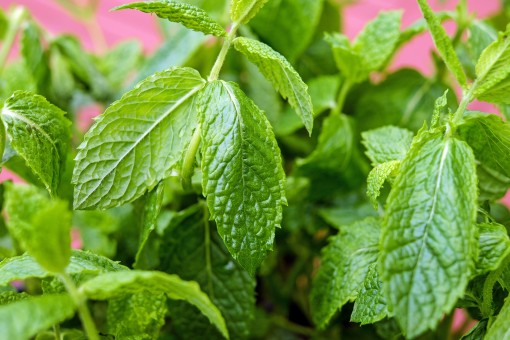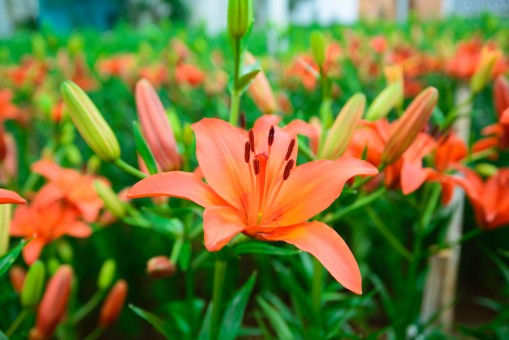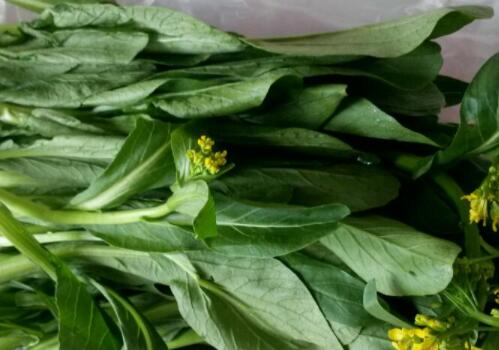What kind of Yindan mint is good? When will you plant it? When will it be picked? How do you plant it?
Peppermint, also known as Yindan grass and night incense, is a common Labiatae plant in the south of the Yangtze River. it is widely planted because it is both edible and medicinal. When will you plant it? When will it be picked? How do you plant it?

I. Variety selection:
The most common cultivated varieties of mint are green stem and purple stem purple vein. The upper part of the stem of the green stem plant is cyan, the leaves are short, oval and glossy, the plant is short and branched, and the high yield characteristic is the most obvious. Purple stem purple vein variety, the plant stem is dark purple, the leaves are oblong, serrated and dense, the branches are less, and the yield is lower than the green stem, but the brain content of the oil is 2% and 5% higher than that of the green stem. In general, the green stem variety is the main variety in the process of mint planting.
2. Planting techniques:
1. Selection of cultivation sites.
Peppermint is not very strict on soil, except for over-sand, over-viscosity, excessive pH and low-lying soil with poor drainage, the general soil can be cultivated, and sandy loam and alluvial soil are better. The suitable pH value of soil is 6.0-7.5. Choose scattered land with sufficient irrigation and drainage conditions, such as ponds, houses and canals, with fertile soil and flat terrain; sandy soil, land with insufficient light and drought and easy to accumulate water is not suitable for planting. Land that has been planted with mint can not be replanted until it has been fallow for about 3 years.
2. Soil preparation and fertilization
Deep ploughing in early spring, ploughing depth of not less than 25 cm, application of potassium sulfate compound fertilizer (15-15-15) 50 kg / mu, 12% calcium superphosphate 100 kg / mu before ploughing, 4000-5000 kg of farm manure fully ripened and dried for more than 7 days, lignin fungus fertilizer 150-200 kg (where possible, farm manure and lignin fertilizer are evenly mixed and fermented for 30 days without direct light) All the above fertilizers are applied in the way of sprinkling. Spray 45-50 kg, or 38% rare earth nitrate spray 50 kg of water. In the early stage of melon expansion, 75 ml of rare earth animal and plant treasure can be used per mu, and 60 kg of water is sprayed.
3. Seed and seedling selection
Peppermint seedlings generally have three propagation methods: rhizome, split plant and cutting. they are planted in a large area and mostly adopt the method of cutting propagation. Cutting propagation in Shandong area is generally from May to June, and the seedling bed is located in sandy soil with convenient transportation and convenient drainage and irrigation. ternary compound fertilizer (15-15-15) 30kg / mu and lignin fertilizer 100kg per mu are used as base fertilizer. After ploughing and raking, the border is 1.2 meters wide, the ridge width is not less than 8 cm, and the ridge height is 12 cm. The sturdy and pest-free aboveground stems and branches were cut into cuttings with a length of 10 cm, and the cutting seedlings were raised according to the row spacing of 7 cm × 3 cm to keep the soil moist. In late June, when the mint seedlings were 10-15 cm high, the wild and mixed peppermint plants were pulled out, and the seedlings were thinned and replenished according to the plant spacing of 10-15 cm.
4. Planting
In southwestern Shandong, mint is usually planted from early October to early November. Before planting, rake the planting field flat and fine, make the border according to the width of 2 to 3 meters, the ridge height is 15 to 20 centimeters, adopt the strip trench planting method, dig the ditch with a row spacing of 30 centimeters to 40 centimeters, the ditch depth is 6 to 10 centimeters, the planting plant spacing is 15 to 20 centimeters, put the peppermint seedling roots evenly in the planting ditch, then cover the soil and suppress slightly. It takes about 200 kilograms to plant roots per mu.
5. Management after planting
(1) weeding by ploughing
In order to ensure the quality and growth potential of mint products, the use of any herbicides is not recommended during the whole growth and development period. In March, shallow and middle tillage is adopted to control weeds, and then shallow and medium tillage is used again after the first harvest. Generally, there are 2 or 3 times of intertillage from planting to harvest.
(2) watering and topdressing
Reasonable topdressing to ensure that the plant is strong but not prosperous, peppermint first stubble should not apply too much nitrogen fertilizer before harvest, otherwise the plant growth is too prosperous, the stem is thin and weak, and lodging is easy to occur in the middle and later stage of growth. When the seedling height is 10 to 15 centimeters, ditching and topdressing fertilizer is generally applied per mu, urea with a nitrogen content of 46% is 8-10 kg, and traditional Chinese medicine lignin bacterial fertilizer is 40 kg. After ridge sealing, 150 times biological fermentation bacteria solution was sprayed on the leaves, once every 10 days, and 2 times continuously.
Peppermint needs more water in the early and middle stages of growth and development. if the weather is dry after planting, water should be watered once every 15 days, and the plant should be watered gently after ridge sealing to prevent the excessive growth of plant stems and leaves, lodging and shedding of lower leaves, and the yield will be reduced. Stop watering 20-25 days before harvest.
(3) Plant adjustment.
When peppermint plants enter the vigorous growth period in May, the terminal buds should be removed in time to promote the growth of lateral branches, stems and leaves (which can increase the yield by more than 10%); the withered leaves in the lower parts should be removed in time, destroyed at a long distance or buried deep in the place.
6. Pest control
(1) Common diseases
① rust. The leaves and stems of peppermint are mainly harmed. In the early stage of the disease, round to spindle-shaped yellow disease spots are formed on the leaf surface, which gradually expand and produce rust-like rust spores. When the damage is serious, the disease is hypertrophic and deformed.
② spot blight. Also known as white star disease, is a fungal disease, which mainly harms peppermint leaves. At the initial stage of the disease, there are round to irregular dark green disease spots on the leaves, the size is 2mm to 3mm, then turn brown, the middle fades to gray, and there are faded edges around. There are small black spots on the disease spot, that is, the pathogen conidium. The leaf tissue around the seriously diseased spot turned yellow, resulting in early defoliation or local death of the leaf.
③ black shank disease. Mainly occurred in the seedling stage, causing mint stem base contraction depression, blackening, decay, plant lodging, wilting and so on, seriously affecting the growth of peppermint.
Comprehensive prevention and control measures of ④.
a. Strengthen field management, pull out diseased plants in time during peppermint growth and take them away from the planting field.
b. Reasonable close planting, keep the field ventilated and transparent; timely drainage after heavy rain; after the previous mint harvest, timely removal of disease and debris, long-distance destruction or short-distance deep burial.
c. Chemical control: rust is controlled by 25% triadimefon 1000-1500 times liquid leaf spray. 70% thiophanate methyl wettable powder is commonly used for the control of leaf blight, foliar spray, once every 7 days and 3 times in a row. 65% Dysen zinc wettable powder 500 times solution was sprayed every 7 days for 3 times in a row to prevent and control the harm of black shank to mint. When using chemical control, be sure to stop using the drug 20 days before harvest.
(2) Common insect pests
① ground tiger. Also known as soil silkworm, root cutter. Mainly in the peppermint seedling stage damage, bite off young roots, resulting in plant death, resulting in lack of seedlings and broken ridges in the field.
② bridge-building worm. The insect mainly harms mint leaves, flowers, buds, fruits and twigs, and seriously affects the growth of plants.
③ prevention and control measures.
a. Combined with land preparation, use 3% phoxim particles 10 grams per square meter, or Beauveria bassiana in planting ditches, 20 kilograms per square meter to control the damage of ground tigers to peppermint roots.
b. Chemical control: physical control measures are mainly used to control bridge insects. The Beginning of Summer to Grain in Beard, traps and kills adults with black light, the general light source is 30cm higher than the mint plant; using the characteristics of adult sugar and vinegar to trap and kill, set up a sweet and sour liquid box per mu, the height is higher than the peppermint plant, cover during the day, open in the evening During the peak incubation period, the eggs were treated with 100x emulsion of Bacillus thuringiensis or sprayed with 10 billion live spores / 500 × 1000x of Bacillus thuringiensis wettable powder.
7. Harvest
Mint is planted in southwestern Shandong and harvested twice a year, the first from late June to early July, no later than mid-July, and the second harvest in early October. Where there are conditions, mechanical harvesting should be adopted. The mint after harvest is spread out on the ground where there is no direct light to dry until 70 to 80%, then tie it into a small handful and place it in a cool and ventilated place to continue to dry.
Time: 2019-03-15 Click:
- Prev

Is cauliflower suitable for growing in dry land? What kind of variety should I plant? What is the time of planting and harvesting respectively?
Cauliflower, also known as golden needle, forgettable grass, day lily, etc., is a common perennial herb of Liliaceae in China. It is used as a health vegetable because of its high nutritional value, tonifying blood, brain, anti-aging and so on. At present, it has been planted in most areas.
- Next

When will cruciferous vegetables be planted and harvested? What is the yield per mu? How do you plant it? What are the technologies?
Green vegetables are also known as Chinese cabbage, rape, small rape. It is cultivated in the north and south provinces of China, especially in the Yangtze River Basin. The tender leaves of green vegetables are used for vegetables, which is one of the most common vegetables in China. When will the vegetables be planted and harvested? What is the yield per mu? How do you plant it? What are the technologies? Learned from the planting base in Yunnan
Related
- Fuxing push coffee new agricultural production and marketing class: lack of small-scale processing plants
- Jujube rice field leisure farm deep ploughing Yilan for five years to create a space for organic food and play
- Nongyu Farm-A trial of organic papaya for brave women with advanced technology
- Four points for attention in the prevention and control of diseases and insect pests of edible fungi
- How to add nutrient solution to Edible Fungi
- Is there any good way to control edible fungus mites?
- Open Inoculation Technology of Edible Fungi
- Is there any clever way to use fertilizer for edible fungus in winter?
- What agents are used to kill the pathogens of edible fungi in the mushroom shed?
- Rapid drying of Edible Fungi

